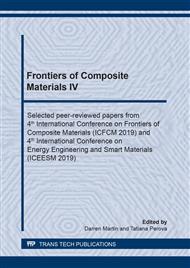p.3
p.9
p.15
p.21
p.27
p.37
p.43
p.49
Thermal Conductivity Enhancement in Polymer-Clay Nanocomposite Using Casting Techniques
Abstract:
Nowadays, there is a need for efficiency and miniaturization in electronic products. However, in the chip level, heat dissipation can limit the performance of these gadgets. Semiconductor industries addressed this thermal management challenge by using thermal interface material. Previous studies have shown that polymer-clay nanocomposite has an enhanced thermal conductivity which can be used as a thermal interface material. In this study, the aim was to determine the effect of casting techniques on the microstructure and thermal conductivity of the polymer-clay nanocomposites. Solution intercalation method was used in fabricating the 5vol% polymer-clay nanocomposite. Organo-modified montmorillonite (MMT) was dispersed in unsaturated polyester (UP) matrix by means of high frequency ultrasonication and formed using two casting techniques; mold casting and tape casting. Results showed a slight increase in the thermal conductivity coefficient of the tape-casted samples at 2.99 W/m-K compared to the mold-casted samples at 2.87 W/m-K. Transmission electron microscopy (TEM) and x-ray diffraction (XRD) results exhibited dispersed microstructure for both casting techniques. Polymer intercalation of ~16% increase in d-spacing of clay for mold-casted samples and with a ~20% increase in d-spacing of clay for tape-casted samples were observed. With these microstructure modifications, the increase in the thermal conductivity coefficient of the tape-casted samples can be attributed to the shear force employed by the tape casting technique.
Info:
Periodical:
Pages:
15-20
Citation:
Online since:
June 2020
Price:
Сopyright:
© 2020 Trans Tech Publications Ltd. All Rights Reserved
Share:
Citation:


